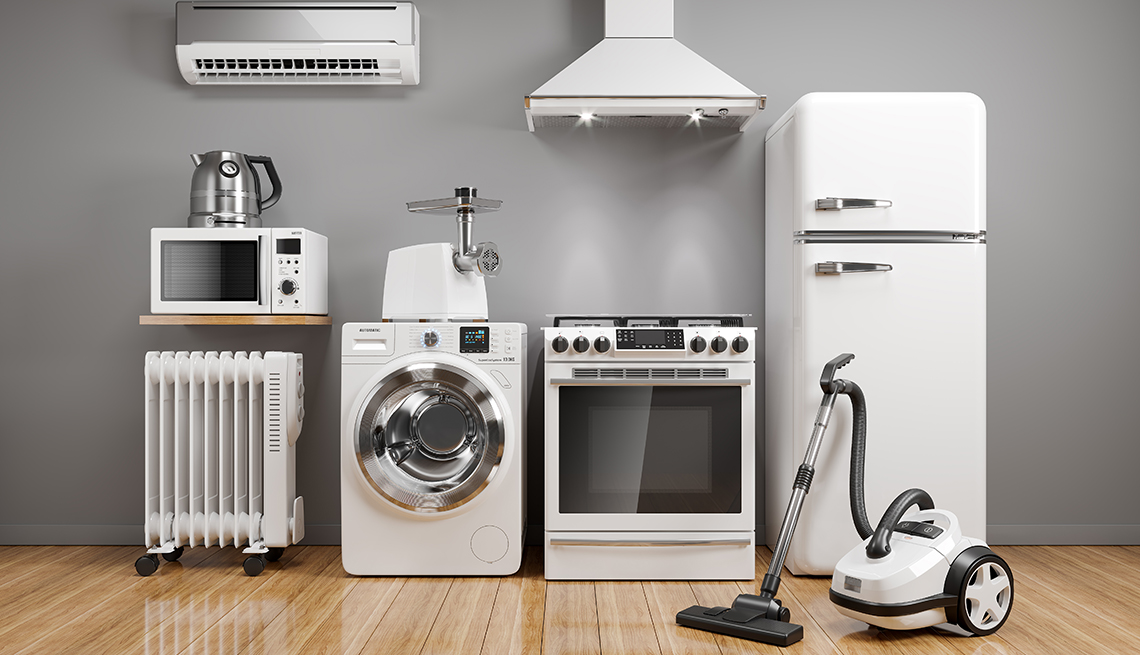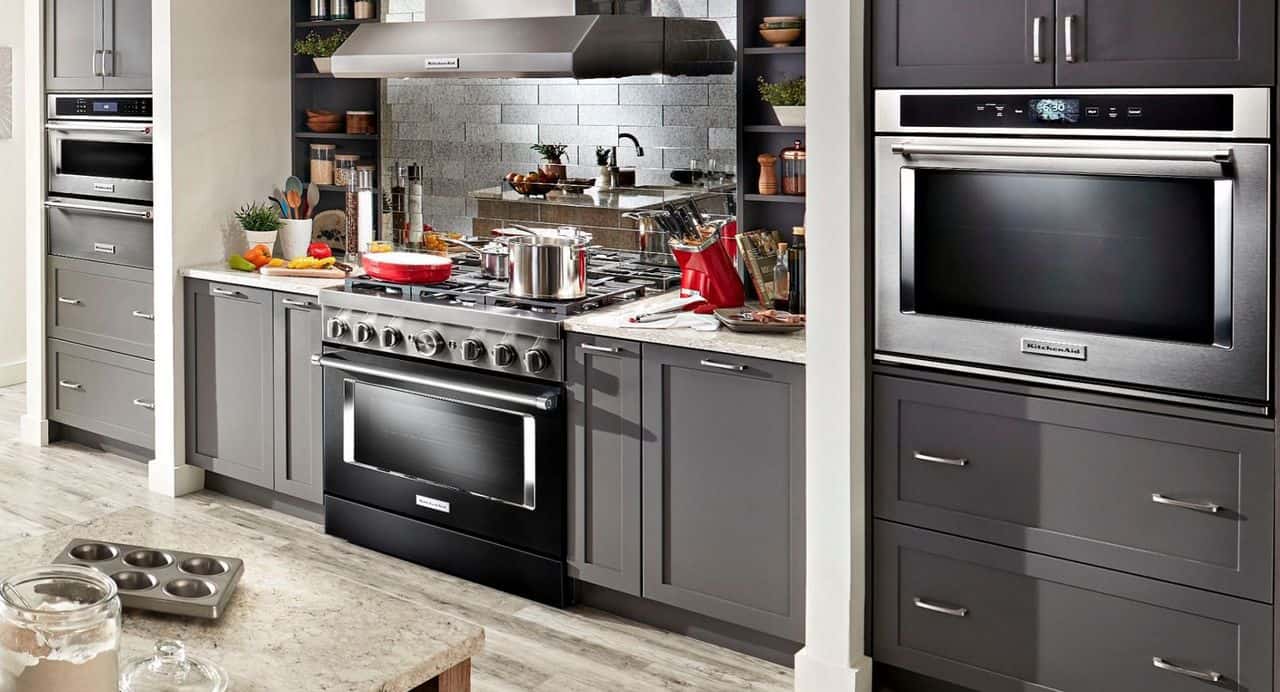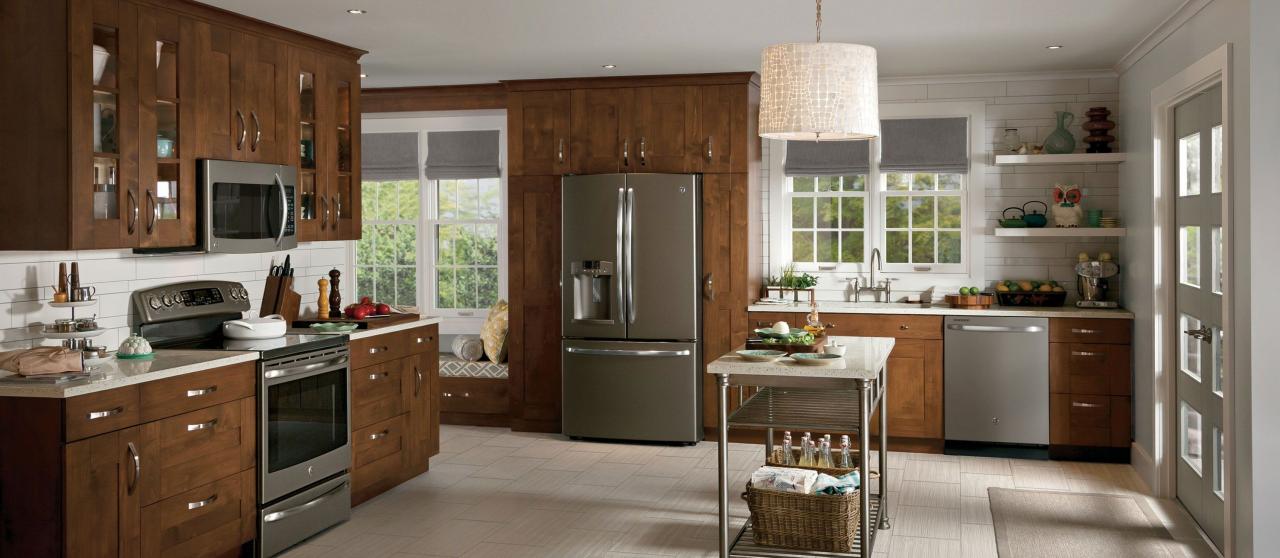Home-garden kitchen-dining major-kitchen-appliances: Dreaming of a stunning kitchen that seamlessly blends indoor and outdoor living? This guide dives deep into designing, equipping, and maintaining the ultimate home-garden kitchen, focusing on the selection and placement of major appliances. We’ll explore design trends, smart appliance features, workflow optimization, sustainable choices, and budget-friendly options to help you create your dream culinary space.
From modern farmhouse aesthetics to minimalist chic, we’ll cover it all, ensuring your kitchen is as functional as it is beautiful.
Get ready to transform your cooking experience with our comprehensive look at everything from energy-efficient refrigerators and smart ovens to the perfect layout for effortless meal preparation. We’ll even tackle the often-overlooked aspects of appliance maintenance and eco-friendly choices, ensuring your kitchen is not only stylish but also sustainable. Prepare to be inspired and equipped to build the kitchen of your dreams!
Home-Garden Kitchen Design Trends: Home-garden Kitchen-dining Major-kitchen-appliances

The modern kitchen is evolving beyond a mere cooking space; it’s becoming a central hub connecting indoor living with outdoor serenity. This integration reflects a growing desire for seamless transitions between the home and garden, creating a holistic and aesthetically pleasing living environment. This trend emphasizes natural light, sustainable materials, and the incorporation of outdoor elements into the overall design.
Modern Farmhouse Kitchen Design with Major Appliances
The modern farmhouse aesthetic blends rustic charm with contemporary functionality. This style prioritizes natural materials like wood and stone, complemented by sleek, stainless-steel appliances. The overall feel is warm, inviting, and effortlessly stylish. Below is a table showcasing the integration of major appliances within this design scheme.
| Appliance | Feature | Design Integration | Material/Finish |
|---|---|---|---|
| Range | Smart features, convection oven, gas or induction cooktop | Freestanding or built-in, focal point of the kitchen | Stainless steel, matte black, or cast iron |
| Refrigerator | French door style, ample storage, ice maker | Integrated into cabinetry or freestanding, near prep area | Stainless steel, white, or custom-matched to cabinetry |
| Dishwasher | Quiet operation, multiple wash cycles, energy-efficient | Integrated into cabinetry, discreet placement | Stainless steel or matching cabinetry finish |
| Microwave | Over-the-range or built-in, sensor cooking | Above the range or integrated into cabinetry | Stainless steel or matching cabinetry finish |
Outdoor Kitchen Elements Integrated into Home-Garden Design
Extending the kitchen outdoors creates an expansive cooking and entertaining area, blurring the lines between indoor and outdoor living. Appliances designed for both indoor and outdoor use are key to this seamless transition. Stainless steel appliances are particularly well-suited for outdoor environments due to their durability and resistance to the elements. Imagine a built-in grill, a weatherproof refrigerator, and a sink all seamlessly integrated into an outdoor patio or deck.
These appliances not only enhance functionality but also elevate the aesthetic appeal of the outdoor space, creating a luxurious and inviting atmosphere perfect for al fresco dining and entertaining. Consider using materials like concrete countertops and natural stone to create a cohesive design that blends seamlessly with the surrounding landscape.
Minimalist Kitchen Design with Major Appliances
A minimalist kitchen prioritizes clean lines, uncluttered surfaces, and a focus on functionality. Major appliances are carefully selected and integrated to maintain a sense of spaciousness and order. Imagine a sleek, handleless refrigerator seamlessly integrated into cabinetry, a built-in oven and microwave hidden behind flush panels, and a minimalist range with a smooth, integrated cooktop. The overall aesthetic is one of understated elegance, with appliances playing a supporting role rather than dominating the space.
The focus is on clean lines, neutral colors, and a sense of calm, creating a sophisticated and functional kitchen that embodies the essence of minimalist design. Strategic lighting further enhances the minimalist aesthetic, highlighting key features and creating a sense of spaciousness.
Dreaming of a stunning new kitchen? Maybe you’re envisioning a spacious rooftop extension to house your dream home-garden kitchen-dining area and those major kitchen appliances. But before you start ordering those bespoke countertops, remember to check the legalities! You’ll need to navigate the process of obtaining planning permission and building permits for rooftop extensions and modifications to ensure your renovation is above board.
Once you’ve got the green light, you can finally focus on choosing those perfect appliances and creating your culinary haven.
Major Appliance Selection and Functionality

Choosing the right major appliances for your home-garden kitchen is crucial for both functionality and efficiency. The selection process should consider your household size, cooking habits, and budget, alongside the energy efficiency and smart features available in today’s market. Making informed decisions in this area can significantly impact your kitchen’s overall performance and your utility bills.
Refrigerator Energy Efficiency Comparison
Understanding the energy efficiency of different refrigerator types is key to reducing your environmental impact and saving money on electricity. Factors like size, features, and technology significantly affect energy consumption.
- Top-Freezer Refrigerators: Generally the most affordable option, these models are typically less energy-efficient than bottom-freezer or French-door models due to their simpler design and less advanced insulation.
- Bottom-Freezer Refrigerators: Offer improved energy efficiency compared to top-freezer models because the freezer is located at the bottom, keeping cold air from escaping as frequently. They also often feature better insulation.
- French-Door Refrigerators: These models usually boast the best energy efficiency among standard-sized refrigerators. Their design, often incorporating advanced insulation and features like automatic defrosting, contributes to lower energy consumption.
- Energy Star Certified Refrigerators: Look for the Energy Star label, indicating that the refrigerator meets certain energy-efficiency standards set by the EPA and Department of Energy. This certification provides a reliable benchmark for comparison.
Oven and Dishwasher Energy Efficiency Comparison
Similar to refrigerators, ovens and dishwashers come with varying energy efficiency ratings. Choosing energy-efficient models can lead to substantial savings over the appliance’s lifespan.
- Ovens: Energy efficiency in ovens varies greatly depending on the type (conventional, convection, induction). Convection ovens, which use a fan to circulate hot air, tend to be more energy-efficient than conventional ovens. Induction ovens, while very efficient, require specialized cookware.
- Dishwashers: Look for Energy Star certified dishwashers and consider features like soil sensors and shorter wash cycles, which can reduce water and energy consumption. High-efficiency models often use less water and energy per cycle compared to older models.
Smart Appliance Features and Benefits
Smart appliances offer a range of convenient features that enhance kitchen functionality and efficiency. These features often connect to your home network or smartphone, allowing for remote control and monitoring.
| Feature | Brand A | Brand B | Brand C |
|---|---|---|---|
| Remote Control | Yes | Yes | Yes |
| Smart Diagnostics | Yes | Yes | No |
| Recipe Integration | No | Yes | Yes |
| Voice Control | Yes | Yes | Yes |
Selecting Appropriate Appliance Size and Capacity, Home-garden kitchen-dining major-kitchen-appliances
Determining the right size and capacity for your major appliances depends heavily on your household size and cooking habits. Oversized appliances waste space and energy, while undersized appliances may struggle to meet your needs.
Revamping your home-garden kitchen-dining space? Major kitchen appliances are key, but don’t forget the fresh ingredients! Growing your own herbs and vegetables adds a delightful dimension, especially when you source your produce from your own backyard, like the amazing options you’ll find when exploring home garden plants. This connection between your garden and kitchen elevates your culinary experience, ensuring fresh, flavorful meals right from your home-garden kitchen-dining setup.
- Assess Household Size and Cooking Habits: Consider the number of people in your household and how frequently you cook. A larger family that entertains often will require larger capacity appliances.
- Measure Available Space: Carefully measure the space allocated for each appliance to ensure a proper fit. Allow for adequate clearance around the appliances for ventilation and ease of use.
- Review Appliance Specifications: Check the manufacturer’s specifications for dimensions and capacity (cubic feet for refrigerators, oven capacity in cubic inches, dishwasher place settings).
- Consider Future Needs: Think about potential changes in your household size or cooking habits in the future. Choosing appliances with slightly more capacity can provide flexibility.
Kitchen Appliance Placement and Workflow

Efficient kitchen design hinges on strategic appliance placement. A well-planned layout minimizes wasted steps, maximizes workflow, and contributes significantly to a more enjoyable and productive cooking experience. Consider your cooking style and the frequency of using specific appliances when determining their ideal location.
Appliance Placement’s Impact on Kitchen Aesthetics and Home Design
The placement of major kitchen appliances significantly influences the overall aesthetic appeal and cohesiveness of your home’s design. A thoughtfully planned layout can enhance the kitchen’s visual balance and harmony. For instance, integrating appliances seamlessly into cabinetry creates a clean, modern look. Conversely, strategically placing statement appliances can serve as focal points, adding a touch of personality and visual interest.
The choice of appliance finishes – stainless steel, matte black, or white – also plays a crucial role in establishing the overall kitchen style and aligning it with the home’s décor. A cohesive design ensures a harmonious flow between the kitchen and adjacent living spaces. Consider the style of your cabinets and countertops when choosing appliances to maintain a consistent aesthetic.
For example, a farmhouse-style kitchen might benefit from vintage-inspired appliances, while a modern kitchen would look better with sleek, minimalist models.
Factors to Consider When Planning Appliance Placement in a Limited Space
Planning appliance placement in a small kitchen requires careful consideration to maximize space efficiency and functionality.
- Prioritize essential appliances: In limited spaces, focus on the appliances you use most frequently and consider multi-functional appliances to save space.
- Maximize vertical space: Utilize wall-mounted shelves and cabinets to store smaller appliances and maximize counter space.
- Compact appliances: Opt for compact models of refrigerators, dishwashers, and ovens designed for smaller kitchens.
- Built-in appliances: Integrate appliances into cabinetry to create a seamless and space-saving design. A built-in microwave above the oven, for instance, can free up valuable counter space.
- Optimize workflow: Arrange appliances to create an efficient cooking triangle (sink, stove, refrigerator) to minimize steps during meal preparation.
- Consider appliance dimensions: Carefully measure the available space and ensure that appliances fit comfortably without hindering movement or access.
Home-Garden Kitchen Appliance Maintenance and Care
Maintaining your kitchen appliances is crucial for extending their lifespan and ensuring optimal performance. A well-maintained kitchen runs smoothly, saving you time, money, and potential headaches down the line. Neglecting regular cleaning and maintenance can lead to costly repairs or premature replacements. This section will provide practical tips and a preventative maintenance schedule to keep your major kitchen appliances in top shape.
Cleaning and Maintaining Major Kitchen Appliances
Regular cleaning is paramount for preventing build-up and ensuring your appliances function efficiently. Different appliances require specific cleaning methods, and neglecting these can lead to malfunctions or even safety hazards. Here’s a breakdown of cleaning tips for some common major kitchen appliances:
- Refrigerator: Wipe up spills immediately. Once a month, remove all items, thoroughly clean the interior shelves and drawers with warm soapy water, and vacuum the condenser coils located at the back or bottom. This helps improve cooling efficiency.
- Oven: After each use, wipe up spills and crumbs. For deeper cleaning, use an oven cleaner according to the manufacturer’s instructions, or create a natural solution of baking soda and water. Remember to always disconnect the power before cleaning.
- Dishwasher: Run a monthly cleaning cycle with a dishwasher cleaner to remove grease and grime buildup. Regularly check and clean the filter to prevent clogs. Pay attention to the spray arms, ensuring they spin freely.
- Microwave: Wipe down the interior after each use. For stubborn stains, steam clean with a bowl of water and lemon juice for a few minutes.
- Cooktop (Gas or Electric): Clean the cooktop after each use to prevent spills from burning on. Use appropriate cleaning solutions for your cooktop type – avoid abrasive cleaners on glass or ceramic surfaces.
Troubleshooting Common Kitchen Appliance Issues
Knowing how to troubleshoot common problems can save you time and money on service calls. While some issues require professional attention, many can be easily resolved with simple fixes.
- Refrigerator Malfunctions: Check the power cord, circuit breaker, and temperature settings. If the refrigerator is not cooling properly, inspect the condenser coils for dust buildup. A consistently warm refrigerator might indicate a more serious issue requiring professional repair.
- Oven Problems: If your oven isn’t heating properly, check the heating elements for damage or debris. Ensure the oven’s temperature setting is accurate and that the thermostat is functioning correctly. A malfunctioning bake element or igniter (for gas ovens) might require professional assistance.
- Dishwasher Issues: Check the water supply, drainage, and detergent dispenser. Clogged spray arms or a dirty filter can also affect performance. A lack of clean dishes might indicate a problem with the water pressure or a faulty pump.
Preventative Maintenance Schedule for Major Kitchen Appliances
Regular preventative maintenance significantly reduces the likelihood of major repairs and extends the lifespan of your appliances. The following table provides a suggested schedule:
| Appliance | Task | Frequency | Notes |
|---|---|---|---|
| Refrigerator | Clean interior, vacuum condenser coils | Monthly | Check door seals for proper sealing |
| Oven | Wipe down interior, deep clean | Monthly/Quarterly | Use oven cleaner sparingly, following instructions carefully. |
| Dishwasher | Run cleaning cycle, clean filter | Monthly | Inspect spray arms for clogs. |
| Microwave | Wipe down interior | After each use | Steam clean for stubborn stains. |
| Cooktop | Wipe down after each use | After each use | Use appropriate cleaner for your cooktop type. |
Sustainability and Eco-Friendly Appliances

Creating a sustainable kitchen isn’t just a trend; it’s a responsible choice for the environment and your wallet. Major kitchen appliances, from refrigerators to ovens, consume significant energy and water resources. Understanding their environmental impact and choosing eco-friendly alternatives can make a considerable difference in reducing your carbon footprint.The environmental impact of kitchen appliances varies greatly depending on their energy efficiency rating, manufacturing processes, and lifespan.
Energy-intensive appliances like refrigerators and ovens contribute significantly to household energy consumption, while dishwashers and washing machines impact water usage. Furthermore, the manufacturing process of these appliances involves resource extraction, production, and transportation, all contributing to greenhouse gas emissions. Choosing appliances with a long lifespan reduces the need for frequent replacements, minimizing waste and resource consumption.
Energy Efficiency and Water Saving Features
Energy-efficient appliances are designed to minimize energy consumption without compromising performance. Look for appliances with high Energy Star ratings, indicating they meet strict energy-efficiency guidelines. Features like advanced insulation in refrigerators, efficient heating elements in ovens, and smart sensors in dishwashers all contribute to reduced energy usage. Water-saving appliances, similarly, incorporate features like low-flow spray arms in dishwashers and efficient washing cycles in washing machines, leading to lower water bills and reduced water waste.
For example, a high-efficiency refrigerator might consume 30% less energy annually compared to a standard model, while a water-efficient dishwasher could save hundreds of gallons of water per year.
Sustainable Materials and Appliance Selection
Choosing appliances made from recycled or sustainably sourced materials is another key aspect of creating a green kitchen. Some manufacturers use recycled steel and aluminum in their appliance construction, reducing the demand for virgin materials. Look for appliances made with durable, long-lasting materials to extend their lifespan and minimize waste. Consider the appliance’s repairability; appliances designed for easy repair and maintenance reduce the need for premature replacement.
Appliances made with less plastic and more sustainable materials, like bamboo or recycled wood for certain components, are also becoming increasingly available. For example, a refrigerator made with recycled steel will have a smaller carbon footprint than one made entirely from new steel. Furthermore, choosing an appliance with readily available replacement parts allows for repair rather than replacement, significantly extending its life and reducing landfill waste.
Budgeting and Financing Major Kitchen Appliances

Revamping your kitchen with new appliances is exciting, but it’s crucial to plan your budget effectively to avoid financial strain. This section Artikels how to create a realistic budget, explore financing options, and save money during the process. Smart planning ensures you get the appliances you want without breaking the bank.
Sample Kitchen Appliance Budget
Creating a detailed budget is the first step towards a successful kitchen renovation. Consider various price points and brands to find the best balance between quality and affordability. This sample budget demonstrates a range of options, from budget-friendly to high-end choices.
| Appliance | Budget-Friendly Option (Brand Example: Frigidaire) | Mid-Range Option (Brand Example: LG or Samsung) | High-End Option (Brand Example: Sub-Zero or Wolf) |
|---|---|---|---|
| Refrigerator | $800 – $1200 | $1500 – $2500 | $3000 – $6000+ |
| Dishwasher | $400 – $600 | $700 – $1200 | $1500 – $3000+ |
| Oven/Range | $500 – $800 | $1000 – $1800 | $2000 – $5000+ |
| Microwave | $100 – $200 | $200 – $400 | $400 – $1000+ |
| Total Estimated Cost | $1800 – $2800 | $3400 – $5900 | $6900 – $15000+ |
Remember that these are estimates, and prices can vary based on features, retailer, and sales. Always check current prices before making any purchase decisions.
Financing Options for Kitchen Appliances
Several financing options can make purchasing major kitchen appliances more manageable. Understanding these options helps you choose the best fit for your financial situation.
- Retailer Financing: Many appliance retailers offer in-house financing plans, often with promotional interest rates or deferred payment options. These plans can be convenient but carefully review the terms and conditions to avoid unexpected fees or high interest rates.
- Credit Cards: Using a credit card with a rewards program can offer cashback or points on your purchase. However, be mindful of interest charges if you don’t pay off the balance in full and promptly.
- Personal Loans: A personal loan from a bank or credit union can provide a fixed interest rate and repayment schedule. This offers more predictability than credit card financing, but requires a credit check.
- Home Equity Loan or Line of Credit (HELOC): If you have equity in your home, a home equity loan or HELOC can be used to finance appliances, but it involves using your home as collateral.
Saving Money on Appliance Purchases and Installation
Saving money on appliances doesn’t mean compromising on quality. Strategic planning can help you get the best value for your investment.
- Shop Around and Compare Prices: Check multiple retailers, both online and in-store, to compare prices and features. Don’t hesitate to negotiate.
- Look for Sales and Discounts: Keep an eye out for holiday sales, clearance events, or manufacturer rebates.
- Consider Refurbished or Certified Pre-Owned Appliances: These can offer significant savings compared to new appliances, but carefully assess their condition and warranty.
- DIY Installation (When Possible): Installing appliances yourself can save on professional installation fees, but ensure you have the necessary skills and tools to avoid damage or injury.
- Negotiate Installation Costs: If you opt for professional installation, don’t be afraid to negotiate the price with the installer or retailer.